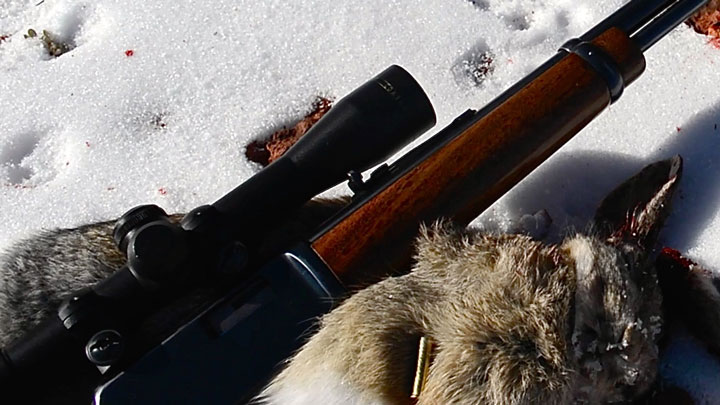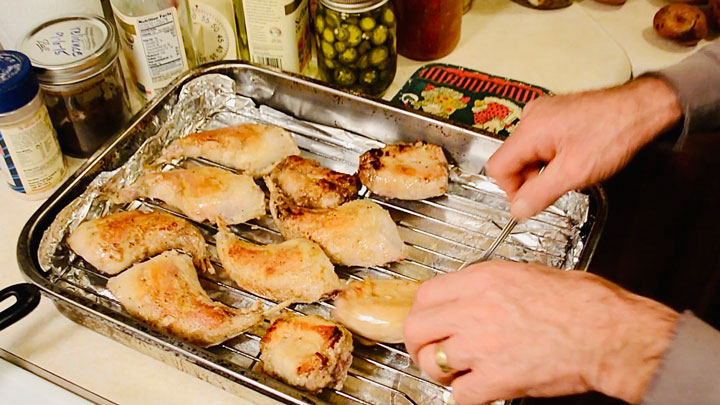
I’ve never been a hardcore small-game hunter, mostly because larger prey like elk and mule deer have always dominated my attention. Never, that is, until a conversation with my friend Greg Nunn had me salivating at the mere thought of hunting rabbits. He told of frosty winter mornings spent stalking cottontails along red sandstone ledges, the shooting skills required to make a clean headshot, and of breaded cottontail browned and sizzling in the oven. I quickly forgot all about elk hunting, and my two little boys and I loaded our .22s into the truck and drove to Greg’s place for a day of rabbit hunting. We learned a lot, shot some cottontails and had an awesome rabbit-fry that night. Here are some tips and tactics that will help you get rabbits in your crosshairs, and frying in your own oven. In fact, I just might give away Greg’s secret rabbit recipe at the end.

Rifles for Western Cottontails
Rabbits are small, delicately assembled creatures, and if shot in the body with even a .22 Long Rifle, they tend to “burst” inside, spreading bowel-matter all over the meat. For this reason, Greg emphasized we only shoot them in the head. If we couldn’t get a good angle for a clean head shot, we passed on the opportunity. A cottontail’s head only makes about a 2-inch target, so as you can imagine, it’s important to use an accurate rifle and shoot very carefully.
The best calibers for western rabbit hunting are .22 LR and .22 Winchester Magnum. (First, of course, check local regs to verify rimfire rifles are legal for hunting rabbits in your state.) Greg hunts cottontails with a lever-action Winchester in .22 WMR mounted with a compact scope, and is impressively deadly with it—we watched him make a perfectly-placed head shot on a rabbit at just over 70 yards. The boys carried a little single-shot .22 LR-chambered T/C Hot Shot with a fixed Leupold 4X rimfire scope, and borrowed my bolt-action .22 LR Ruger Model 7722, mounted with a compact Leupold 2X-7X-36mm scope for longer shots. Both worked well.

The ideal rimfire rabbit gun will be accurate, comfortable to carry and fit you well. Mount a good little scope on it, because while you can head-shoot cottontails with iron sights, a scope will provide a much better sight picture and enable you to make longer shots. Most shots at western rabbits occur at ranges from 10 to 50 yards. I like to zero my rifle at 50 yards, then learn where to hold my crosshairs to hit dead center on closer or more distant targets. The bottom of a pop can makes a good practice target, since it’s about the same size as a cottontail’s head.

Rabbit Ammo
Here again, accurate shooting is important when hunting cottontails. Pick up a few different brands of quality .22 ammo and test to see which your rifle likes best. Then zero your rifle and hunt with that ammunition.
Tactics for Hunting Western Cottontails
Cottontails love brushy cover, especially old woodpiles, bulldozed brush and thorny thickets. They like to den in holes under big rocks or ledges, and they’ll hop out and sit on or at the base of those rocks and ledges in the morning and sun themselves. As the sun crests the western mountains, stalk slowly along the base of sloping little foothills and canyon walls. Look for places the morning sun will warm, and search for rabbits catching a few rays. Keep an eye on shadowed draws and small openings for cottontails nibbling breakfast. Later in the morning, hunt the foothills and ledges again, looking for more rabbits taking a morning sunbath.
While you’re hunting, keep an eye out for cottontail sign, such as little flat piles of pea-sized, bean-shaped droppings, dusting pits under ledges where rain and snow don’t reach, and clipped areas of rabbit brush and snakeweed. Tracks are also a firm sign there are cottontails currently using the area, especially if there are fresh tracks in snow. Find tracks and you’ll find rabbits.

Usually (though not always), rabbit activity slows during midday, so fix a lunch, take a nap and do a little plinking to hone your shooting skills during midday hours. As afternoon shadows lengthen, renew your search, now hunting along brush-edged flats and openings for cottontails emerging to feed. Arroyos and washes can be awesome—look for rabbits feeding along the edges that rim the arroyo. Shots can be longer now, as rabbits are easier to spot at a distance, nibbling grass on the far side of a flat. Carry a set of shooting sticks to help you make those longer shots.
Hunting cottontails is an awesome way to hone your shooting skills in the field. Come fall, that elk will feel like a pretty big target.

Cleaning Cottontails
The quickest way to clean a rabbit starts with donning a pair of rubber gloves. Next, step on the rabbit’s head and pull on the body until it detaches. Now peel the skin away (you won’t need a knife, the skin tears and peels off easily), trying to keep fluff away from the meat. Reach inside and pull the heart, lungs and offal free, and discard. Repeat with the genitalia. Use a pair of shears to snip the legs free at or just above the knee joint. With a little practice, this entire process can be performed inside 90 seconds. Rinse the rabbit in water or snow, and place it in a gallon-sized Ziploc freezer bag.
NOTE: Some rabbit hunters like to leave their rabbits for an hour or so, then return and process them. This gives any fleas that might be present a chance to jump ship to someplace other than the hunter. If you do process your rabbits immediately, simply keep a close eye on your sleeves and cuffs for tiny black fleas. If you spot any, eliminate them before they get inside your clothing.

Greg’s Baked Rabbit Supreme
Here’s a way to prepare cottontail rabbits that’ll eclipse Granny’s fried chicken. You will need:
- One or more cottontails
- Frying pan and oven
- Safflower or canola oil
- Flour
- Salt and pepper
- Sage
- Water
First, brine your rabbits in salt and cold water (about two teaspoons of salt to every quart of water) for 12 to 24 hours. Rinse. Next, quarter your rabbits. Remove the lower ribs from each carcass and discard, leaving the backstraps both intact on the backbone. Meanwhile, pre-heat your oven to 350 degrees. Now mix flour, salt, pepper, sage and any other desired seasonings in a bin. Toss in the cottontail pieces, add a lid and shake until the meat is thoroughly breaded. Then sear the meat in a hot frying pan with oil for approximately four minutes on each side. Place in the oven and bake for 50 minutes. Serve with steamed veggies, mashed potatoes and rolls. Enjoy!



































